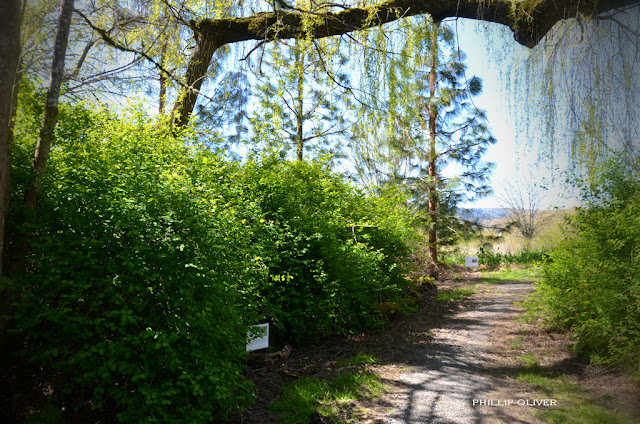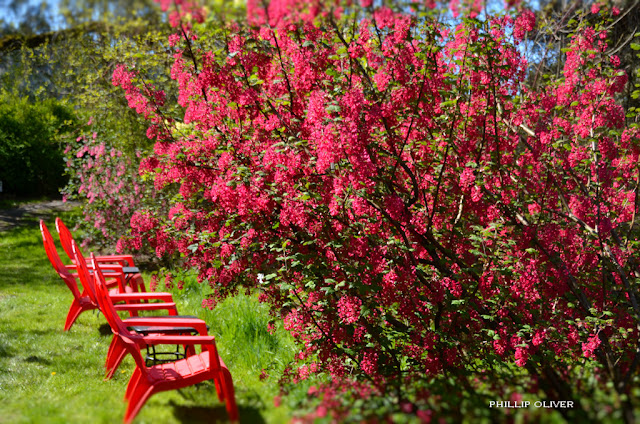I have been doing some gardening work in Jane and Mark's garden on Sauvie Island and took some extra time on my last visit to take some photos.
Their property is incredible and every time I go I discover new wonders. When I first started pruning roses for them back in early March, Mark told me that in a few weeks the whole landscape would burst into leaf and bloom. Every week, there is something new to see and the bird and wildlife is astounding.
Jane Hartline has a native plant nursery on the premises (Sauvie Island Natives) and she is a walking encyclopedia of plant knowledge. I am learning a lot about native plants!
The above photos show the lovely native shrub, the flowering currant (Ribes sanguineum) which grows in abundance here.
The property is a large one with gardens all around the house and a pond further out. A trail extends around the pond and that is where most of these photos were taken.
 |
Pacific Ninebark (Physocarpus capitatus)
|
 |
Snowberry (Syphoricarpos albus) is also in abundance here.
|
 |
Grand Fir (Abies grandis)
|
The garden serves as an educational labatory and informative signs are placed along the trails. This sign describes the Willamette valley prairie which has been duplicated in the above photo.
 |
In the distance, you can see the Sauvie Island bridge which is the only way onto the island. Portland is to the east.
|
 |
At another point along the pond trail, you get a clear view of Mt. Saint Helens in Washington.
|
 |
Look closely around the ground or in the trees and wildlife is abundant.
|
 |
Oregon Grape (Mahonia aquifolium)
|
The gardens around the house are just waking up and there will be much more to see in the coming weeks. A few plants of interest already -
 |
This huge Kerria brings back memories of our Alabama garden.
|
Hopefully I can get more photos as the season progresses. There is so much to see here.
Text and photos by Phillip Oliver, Dirt Therapy




































Beautiful photos Phillip! I can't imagine gardening on such a large piece of land. I guess I could finally grow all the magnolias I don't have room for here.... and I'd have water too!
ReplyDeleteOn one hand, I would love that much space but then again, I do like my smaller garden because I can half-way keep up with it. Speaking of magnolias, I've been admiring 'Sunburst' at our nursery. It is so beautiful!
DeleteOh, to have that much land - and a pond too! Absent a win in a major Powerball lottery, that's well beyond most gardeners' reach in coastal SoCal. I love Ribes sanguineum. I killed one here but I've been tempted to try another. At this point, I make do with Ribes viburnifolium, which blooms well but is far less spectacular.
ReplyDeleteThis is certainly my kind of place. Beautiful in a very natural way.
ReplyDeleteI think it's very cool and commendable that they are trying to restore, at least partially, the wet prairie. The abundance of birds is a testament to the their success. How did you find this gig?
ReplyDeleteI pruned roses for a neighbor of theirs who I know through HPSO. She recommended me to them.
DeleteIf I might add--the gardeners are very lovely, too! And maybe native!
ReplyDeleteI love that nursery! Strolling their restoration garden is an honor too. Such good caretakers of the earth. Those Ribes are the best. Nice to know you are helping them with some pruning!
ReplyDelete(I think your 7th & 8th pictures are Sambucus, not Ninebark.)